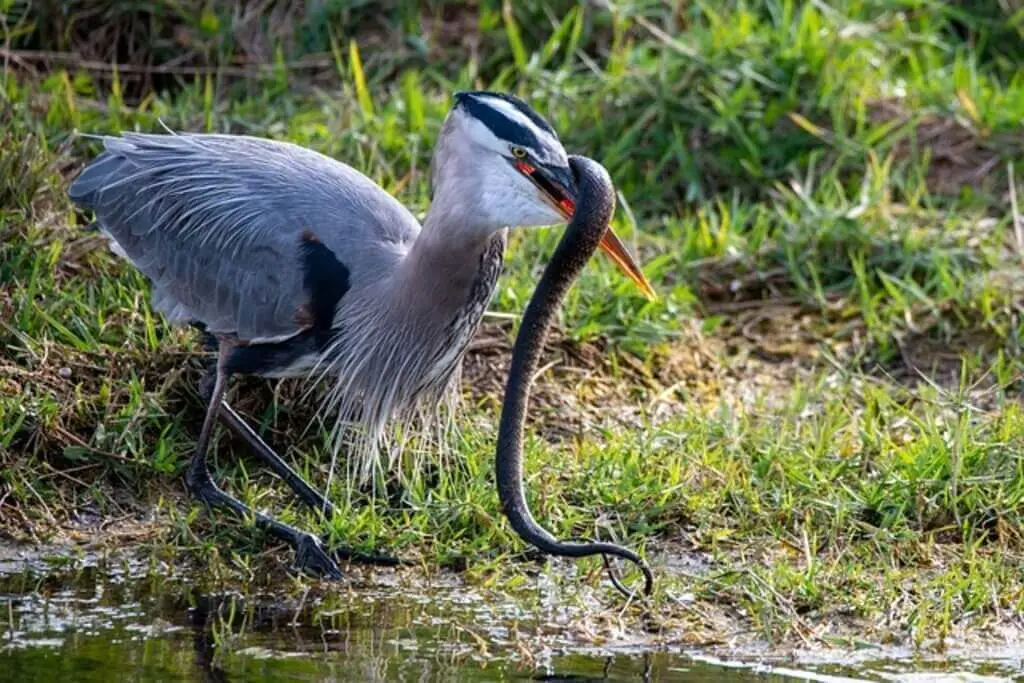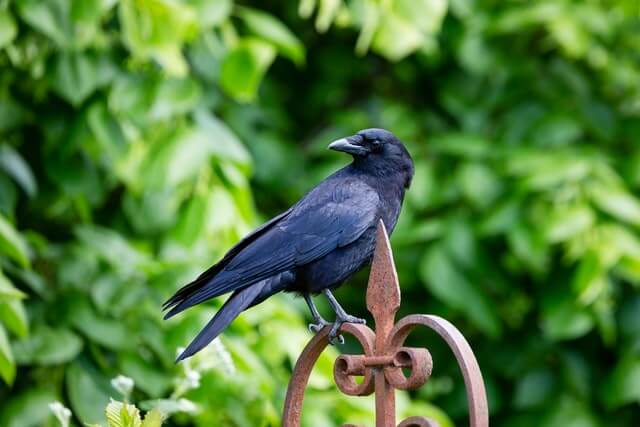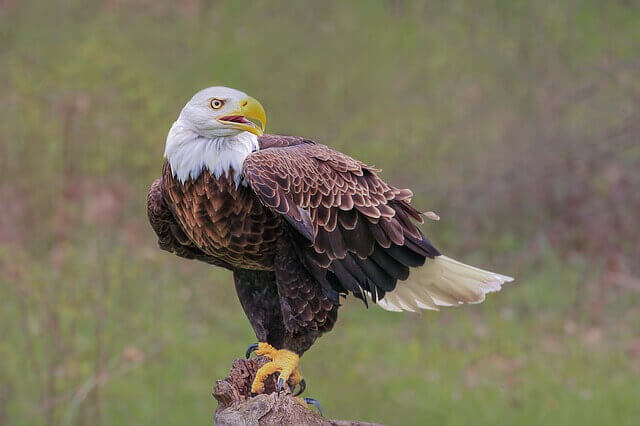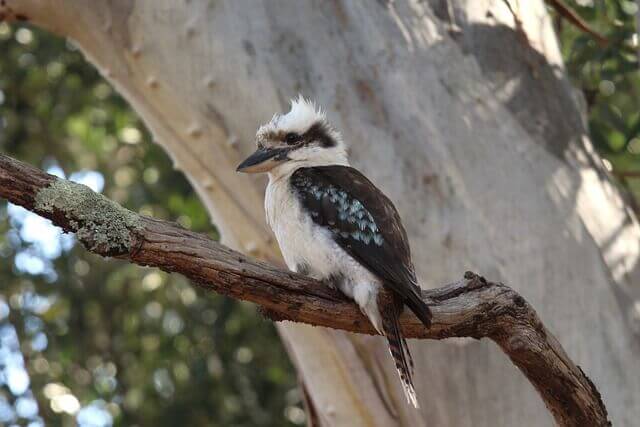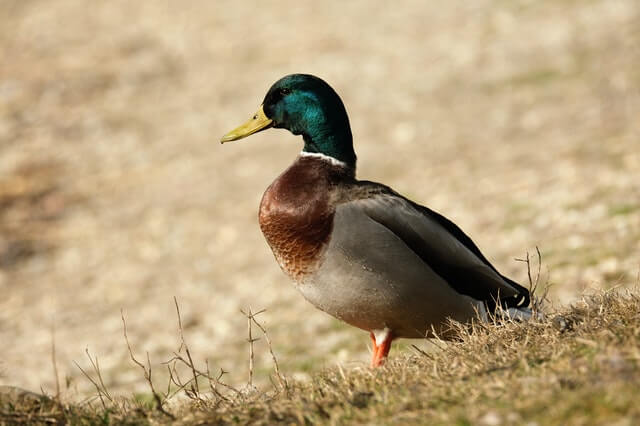Snakes have a reputation of being slimy, dangerous creatures. But did you know that there are actually several species of birds that eat snakes? In this article, we will introduce you to 25 different kinds of birds that hunt and eat snakes. We will also provide identification tips, fun facts and more. So read on to learn more about these amazing predators!
Table of Contents
- 1 Birds That Eat Snakes
- 1.1 Hawks
- 1.2 Vultures
- 1.3 Owls
- 1.4 Crows
- 1.5 Roadrunners
- 1.6 Eagles
- 1.7 Falcons
- 1.8 Peacocks
- 1.9 Laughing Kookaburras
- 1.10 Herons
- 1.11 Secretary Bird
- 1.12 Cranes
- 1.13 Chickens
- 1.14 Wild Turkeys
- 1.15 Geese
- 1.16 Ducks
- 1.17 Ostrich
- 1.18 Cassowary
- 1.19 Greater Rhea
- 1.20 Emu
- 1.21 Crested Caracara
- 1.22 Rooster
- 1.23 Stork
- 1.24 Anhinga
- 1.25 Brown Snake Eagle
- 2 Frequently Asked Questions
- 3 Author
Birds That Eat Snakes
Hawks

Hawks eat snakes because they are opportunistic predators and snakes make for a quick meal. Hawks will generally fly above the ground, searching for prey with their keen eyesight.
They may catch the snake by swooping down and grabbing it in their talons or beak. If the hawk is not able to grab it right away, he will then drop from his perch and continue chasing after it until he can grasp it again.
Related Post: 32 Fun Facts About Hawks
Vultures

Snakes and vultures don’t often come into contact with one another. But do vultures eat snakes? The answer is yes, they do. If you see a dead snake on the ground, it’s likely that a hungry vulture will pick up the scent of fresh meat and fly down to snatch it up for an easy meal.
The most common prey items include insects, small mammals such as mice and rabbits, reptiles such as lizards and snakes, fish, large invertebrates like scorpions.
Related Post: 18 Facts About Turkey Vultures
Owls
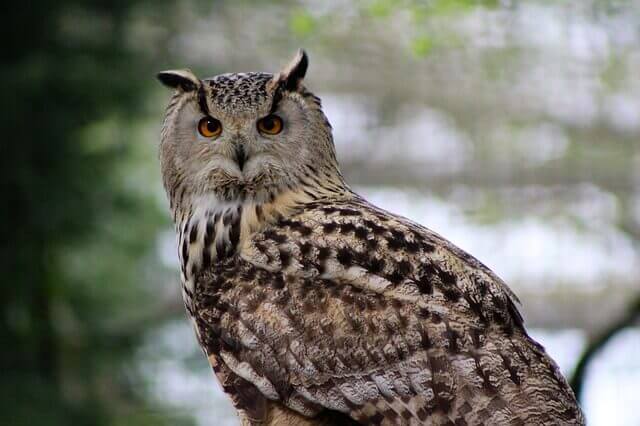
Do owls eat snakes? The answer is yes. Owls are predators and as such, they do consume other animals, including reptiles like snakes. Snakes make up a small percentage of the diet for most species of owl, but some species rely on them a little more.
For example, the barn owl mainly eats rodents but also has been known to hunt and eat other small mammals like shrews and bats; it will also prey on amphibians, lizards, birds, and insects.
Related Post: 17 Fun Facts About Owls
Crows
Crows are one of the most common birds in North America. They are omnivores, eating both animals and plants. Crows are opportunistic feeders, so they’re going to attack anything that moves in their vicinity.
Snakes are not common prey for crows, but they do occasionally hunt them when other food sources are scarce. Crows have been observed eating small constrictors such as rat snakes and garter snakes in some areas.
Related Post:
Roadrunners
The roadrunner is a North American bird that inhabits the southwestern United States and northern Mexico. Roadrunners are omnivores, this means that they eat both animals and plants.
Roadrunners have been observed eating snakes as well as other small mammals such as lizards, rodents, and insects. A roadrunner’s long, slender beak is perfect for eating venomous snakes such as rattlesnakes and copperheads.
Related Post: 32 Fun Facts About Roadrunners
Eagles
Eagles are well known for their long wingspan and majestic call. However, did you know that they also eat snakes? Eagles will often prey on rattlesnakes, cottonmouths, and other types of venomous snakes because they can’t be harmed by the snake’s poison.
They’ll grab the snake with their talons then use their powerful beak to tear off chunks of flesh until it’s dead.
Related Post:
Falcons

Have you ever seen a falcon swoop down and grab a snake from the ground? It might be difficult to believe, but falcons actually eat snakes. A common food for these birds is the Eastern Grass Snake, which can grow up to 4 feet long.
When hunting, they will frequently fly up and perch on trees or telephone poles before spotting their prey. They will then dive at it and grab it with their talons before flying back up into the air again.
Related Post:
Peacocks
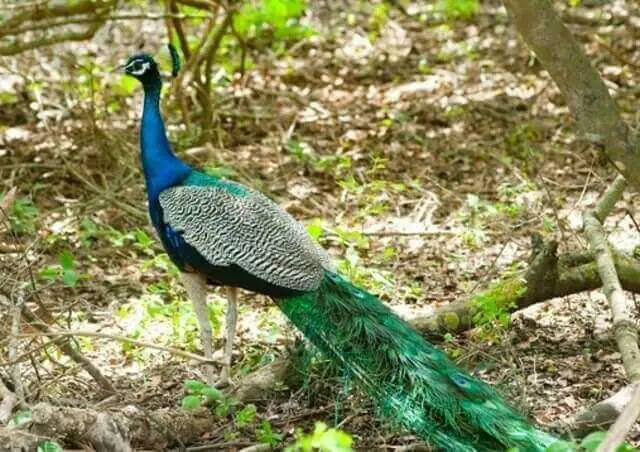
Peacocks are beautiful, with their shimmering feathers and gorgeous tails. Many people do not know that peacocks also have a voracious appetite for snakes! A Peacock will hunt out even poisonous snakes.
When they see a snake, the peacock will chase it and then pick it up by its tail. The peacock then swings the snake around its head like a lasso to kill it before eating it.
Laughing Kookaburras
Did you know that Kookaburras eat snakes? In Australia, the Laughing Kookaburra is a carnivorous bird. In addition to small mammals and lizards, one of their favorite meals is to prey on snakes.
They usually use their claws to dispatch the snake before eating it headfirst. This behavior is most likely related to the competition for food sources in their habitat as well as predation on some of their own species.
Herons

Herons are large, long-legged wading birds that are often seen standing in the water. They have a long neck and a sharp beak for catching fish. Herons eat other animals too, including frogs, lizards, mice, and even snakes!
Herons will attack any snake that enters its territory but prefer smaller ones like water snakes, rat snakes, or even juvenile rattlesnakes if they’re hungry enough. They can eat as many as six snakes in one sitting.
Related Post: 10 Great Blue Heron Facts
Secretary Bird
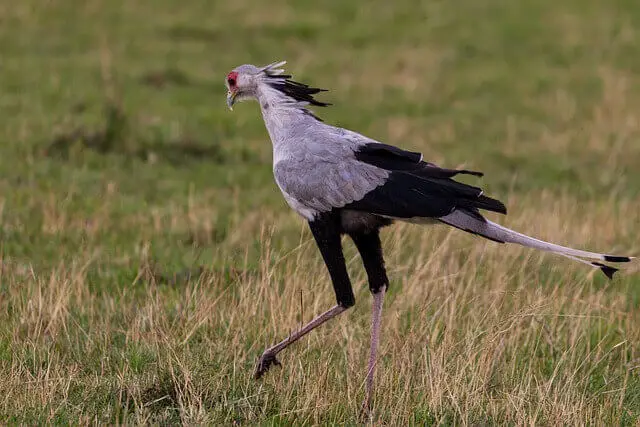
Secretary Bird is a specialist when it comes to hunting snakes. They are found in the savanna of Africa and spend most of their time searching for poisonous snakes like cobras, puff adders, mambas, and many more.
Secretary birds can find these poisonous serpents by sight or smell. Once they spot one, they stomp down on them with their feet, with a force of five times their body weight before devouring them whole.
Cranes
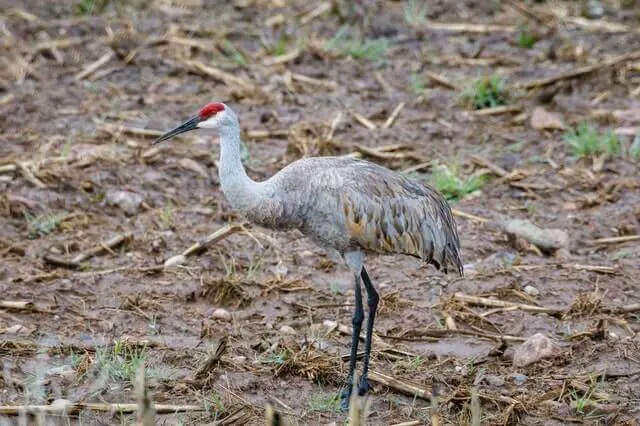
Did you know that cranes eat snakes? They’re not afraid of the danger! Snakes are one of their favorite foods. The long-legged, majestic crane is known for its graceful flight and dainty dance on the ground.
These gentle giants are also some of nature’s most tenacious predators. The cranes don’t shy away from eating anything—including other birds and small mammals like rodents, frogs, lizards, and even large insects like grasshoppers or dragonflies.
Related Post:
- 60 Interesting Facts About Common Cranes
- 48 Interesting Facts About Whooping Cranes
- 52 Fun Facts About Sandhill Cranes
Chickens

Chickens are widely considered to be herbivores because their diet consists primarily of seeds, vegetables, nuts and grains. But did you know that chickens do eat other animals, including small mammals and small snakes!
Chickens will hunt down these creatures if they are given the opportunity. They seem to prefer rodents like mice and rats, but they also consume birds and lizards too.
Wild Turkeys
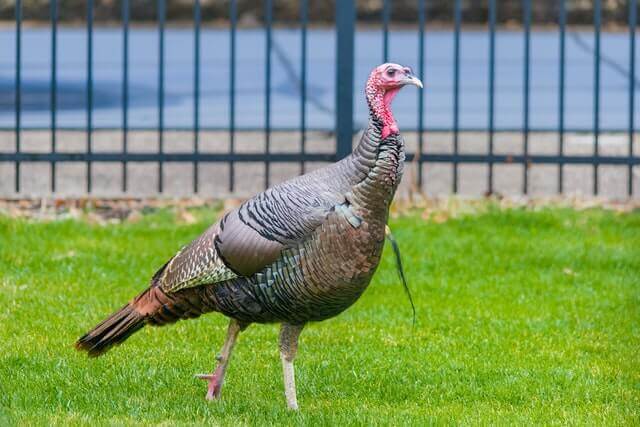
Did you know that wild turkeys will eat snakes? The turkey is a bird in the order Galliformes, which includes chicken and grouse. Turkeys have very diverse diets, but they are known to occasionally consume small reptiles such as lizards and snakes.
This is unusual for most birds because of their inability to break down the snake’s tough outer skin. Wild turkeys may also eat other small animals including insects, worms, seeds, fruits and berries.
Related Post: 6 Birds That Look Like Turkeys
Geese

Geese are mostly herbivores and rarely eat animals. However, when they do eat meat, it is usually small mammals or fish that they have found on the ground or caught in a nearby body of water. There are many documented cases of geese eating snakes, but this is not very common.
Geese will feed on the occasional snake if one happens to be near their nesting area, however, there has never been a case where geese were observed hunting for snakes specifically to consume them.
Ducks
Ducks are well known for their distinctive call and quack. Ducks are omnivores, meaning they can eat both plants and animals. It is not commonly known that they will also eat snakes, specifically garter snakes.
Garter snakes often inhabit the same area as ducks and can be a significant food source for them. Ducks are natural hunters with keen eyesight, fast reflexes, sharp beaks, and powerful claws.
Related Post: 23 Fun Facts About Ducks
Ostrich

Ostriches are native to Africa and the only member of the Struthionidae family. The ostrich is widely considered to be the largest living bird in the world. They can grow up to 9 feet tall and weigh between 140 and 320 pounds. Ostriches have long necks, legs, and wings. Their wings are not used for flying, but help them balance when running. Ostriches are among the faster animals on land, and are capable of reaching speeds of up to 43 miles per hour (69 km/h).
Ostriches live in Africa in dry, open habitats such as savannas, woodlands, and steppes. They are common in countries south of the Sahara Desert. They are found in countries like Ethiopia, Kenya, Tanzania, and South Africa. The ostrich’s diet consists mostly of plants, though it also eats insects and small animals. Ostriches do not typically eat snakes, but they have been known to kill and eat them on occasion.
Cassowary
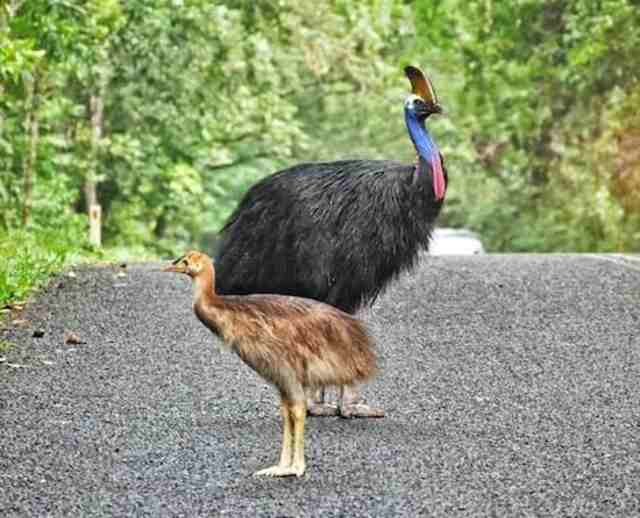
The Cassowary is a large, flightless bird that is native to the tropical forests of New Guinea and northern Australia. The Cassowary is the only member of the genus Casuarius and is classified as a ratite, which means it is related to the ostrich, emu, and rhea. The Cassowary is a shy and reclusive bird that is most active during the day.
The diet of the Cassowary consists mainly of fruits, but they will also eat leaves, insects, and small animals. The Cassowary has been known to eat snakes, but this is not a common occurrence. The Cassowary has a distinctive call that has been described as sounding like a donkey braying or a dog barking. The call of the male Cassowary is much louder and deeper than that of the female.
Greater Rhea
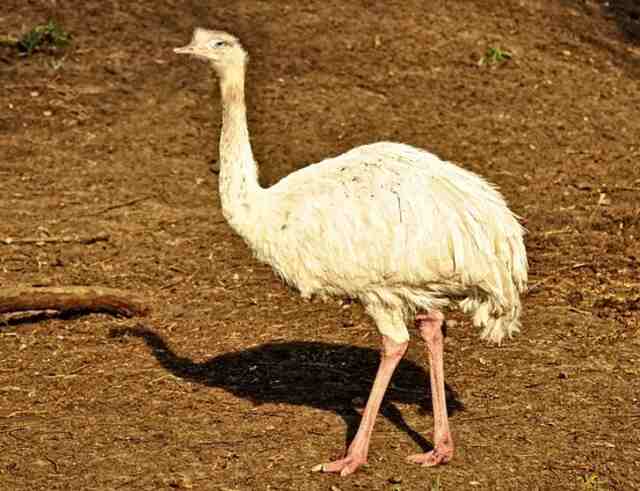
Greater Rheas are a large species of flightless bird that is native to the South American continent. They are closely related to ostriches and emus, and are the largest birds in the world that cannot fly. Rheas can grow up to six feet tall and weigh up to 150 pounds. Their plumage is mostly white, with some black on their wings and tail.
Rheas live in open grasslands, savannas, and woodlands. They are most active during the day and spend much of their time grazing on grasses and other plants. Rheas also eat insects, small mammals, and reptiles. They have been known to kill and eat snakes, but this makes up a small part of their diet.
Emu
The emu is a large flightless bird from Australia. The largest living member of the order Dromaiiformes, it is also the second-largest living bird by height, after its relative, the ostrich. Emus can reach up to 1.9 meters (6.2 ft) in height and weigh up to 90 kilograms (200 lb). They have long necks and legs, and can run at speeds of up to 50 kilometers per hour (31 mph).
Their diet consists mostly of plants, but they are also known to eat insects, small reptiles, and even snakes. Emus are not afraid of humans and will often approach them in search of food. In fact, they have been known to steal food from campsites and picnic baskets!
Crested Caracara
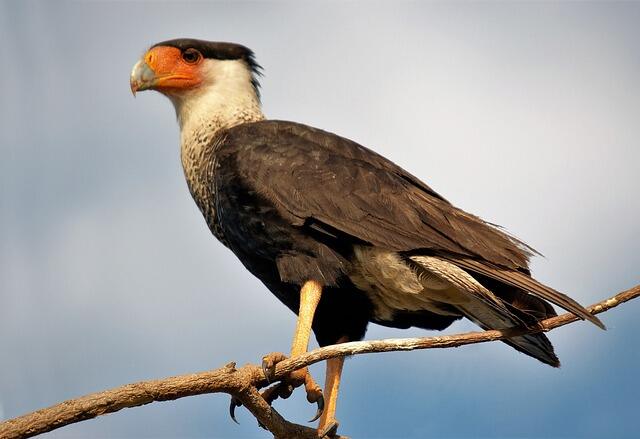
The crested caracara (Polyborus plancus) is a large bird of prey found throughout the southern United States, Mexico, and Central and South America. The species ranges from southern Canada to Tierra del Fuego, and is the only member of the genus Polyborus. Caracaras are opportunistic feeders, and their diet includes a wide variety of small animals such as rodents, lizards, birds, and snakes.
They will also eat carrion, fruits, and nuts. In some areas, they are considered pests because they will raid crops for food. The crested caracara prefers open habitats such as grasslands, savannas, and deserts. It can also be found in forest edges and clearings, as well as coastal marshes.
Rooster

The rooster is a chicken that is typically found on farms. They are kept for their meat and eggs, but also serve as watchdogs and are used in some cultures for divination. The term “rooster” originally referred to the adult male chicken, but now it can refer to both sexes. Male chickens are also known as cockerels, while female chickens are called hens. Roosters are usually red or white, but they can be other colors as well.
Roosters are found all over the world, but they originally come from Asia. They typically live in warm climates and prefer to be in open areas, so they can see predators coming. Roosters usually eat insects, small mammals, and reptiles. They have been known to eat snakes, but this is not their preferred diet.
Stork
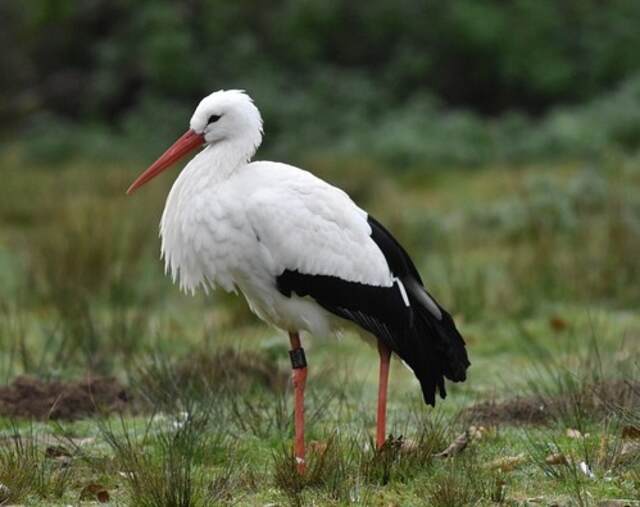
Storks are large, long-legged, long-necked wading birds with mostly white plumage and black wings. They occur in many different habitats, including wetlands, woodlands, grasslands, and even deserts. Storks eat a variety of food items, including insects, small mammals, reptiles, and fish.
They typically catch their prey by wading through shallow water and using their long beaks to snag their food. Although they are not known to specifically hunt snakes, storks will occasionally eat them if they come across one.
Anhinga
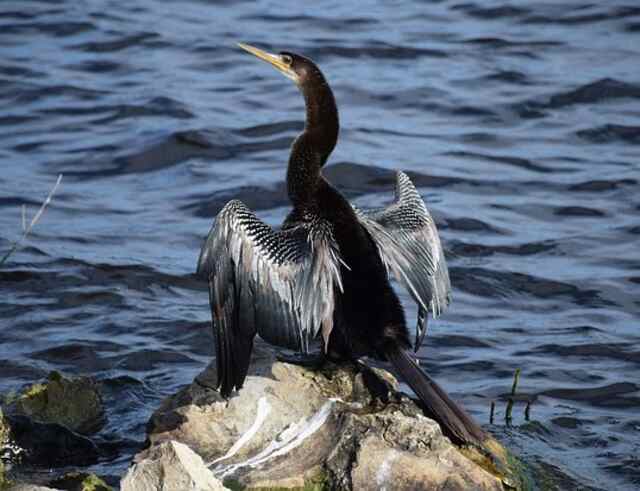
The Anhinga is a large, long-necked bird found throughout the southeastern United States. Their range extends from Texas to Virginia, and they are most commonly found in Florida. Anhingas prefer freshwater marshes and swamps, but can also be found in saltwater habitats. Anhingas are carnivores, and their diet consists mostly of fish.
They will also eat reptiles, amphibians, and small mammals. Anhingas are known to feed on snakes, which they catch with their sharp beaks. Anhingas are silent birds, but they can make a hissing sound when threatened. These birds are shy around humans, but can often be seen sunning themselves on logs or branches near water.
Brown Snake Eagle
The Brown Snake Eagle is a large raptor that is found in West, East and southern Africa. They prefer to live in wooded areas near water sources, such as lakes or rivers. Their diet consists primarily of snakes, but they will also eat other small animals, such as lizards, rodents and birds. Brown Snake Eagles are incredibly skilled at hunting snakes. They will perch in trees and scan the ground for their prey.
When they spot a snake, they will swoop down and grab it with their powerful talons. They will then kill the snake by either crushing it or drowning it in water. Despite their name, Brown Snake Eagles are not exclusively brown in coloration. Their plumage can range from light brown to almost black. Juvenile birds are usually lighter than adults.
Frequently Asked Questions
Do Mockingbirds eat snakes?
Mockingbirds are native to North America and belong to the Mimidae family. The bird is typically found in open woodlands, thickets, brushy edges of forests, and suburbs with trees. Mockingbirds will eat many different types of insects as well as spiders and caterpillars. They will also eat small frogs, lizards, and even snakes (very small ones).
Do Eagles eat pythons?
Eagles are predatory birds and will eat any animal they can find. One of the animals that eagles prey on is the python, a non-venomous snake found in Asia and Africa. The eagle uses its sharp talons to hold onto the python’s body while it eats. Eagles often attack pythons when they’re sunning themselves on branches or logs as well as after ambushing them from high up in trees.
What bird eats venomous snakes?
Have you ever wondered what bird’s eats venomous snakes? These 6 birds will satisfy your curiosity! The laughing falcon, harpy eagle, peregrine falcon, red-tailed hawks, great-horned owl and secretary bird are all known to eat poisonous reptiles.
Do Hawks eat Copperheads?
Hawks have been known to consume a wide range of snake species including the venomous Copperhead snake. While most people would think that this is not a good idea for the hawk, it actually poses no threat as hawks have stomachs with an acidic lining which can break down and digest anything from small bones to eggs without issue or harm to themselves.
Why do Secretary birds stomp snakes?
Secretary birds are a type of bird that live in Africa and India. They have very powerful feet and claws that they use to fight against venomous snakes such as cobras. The secretary bird’s hunting technique involves stomping on the snakes head with massive force before eating them. This prevents any chance of being bitten by the snake.
Do Golden Eagles eat rattlesnakes?
There have been a few instances where golden eagles have been seen feeding on snakes, but it is not a common occurrence. It is more likely that these eagles were just passing through and found a snake along their way to hunt for other food sources such as rodents or rabbits.
Do Pheasants eat snakes?
Do pheasants eat snakes? Yes. Pheasants are ground-dwelling birds that live in open areas such as grasslands, savannas, and wetlands. These herbivores typically feed on seeds, insects, and other small animals. They do not have a problem eating a snake if they happen to come across one while foraging for food!
Do Hawks eat rattlesnakes?
Hawks are raptors that eat a variety of prey. They have been known to hunt and kill rattlesnakes, although they primarily feed on small mammals such as mice and voles. In the wild, hawks will not typically attack a snake unless it is easy to capture or in the process of being eaten by another animal.

